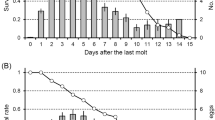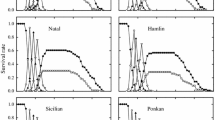Summary
Reproductive compatibility was studied among populations of different types of the citrus red mite,Panonychus citri (McGregor), i.e., the diapausing type from pear (DP), the non-diapausing type from citrus (C) and that from pear (NP).
Copulation was also observed between mates of different types (DP and C). Only in crosses between C ♀ and DP ♂, was copulation occasionally broken off prematurely; duration of copulation varied considerably between pairs and the average duration was much shorter than that between DP ♀ and C ♂ and than that in crosses between mates of the same types.
No F1 adult females were produced at all from crosses between DP and C, showing that there was a complete reproductive isolation between the two types. There was a significant reciprocal difference in the egg hatchability and survival rate of immatures in the F1 progeny; mortality in the eggs and that in the immature stage were significantly higher in crosses between DP ♀ and C ♂, as compared to those in the reciprocal cross. This suggested that fertilization may have occurred in the former cross, whereas it seemed that eggs were not fertilized in crosses between the C ♀ and DP ♂.
The NP was compatible with the C, whereas it was completely incompatible with the DP. Thus, there was a complete reproductive incompatibility between the diapausing and non-diapausing type ofP. citri.
Similar content being viewed by others
References
Boer, deR. (1980) Genetic affinities between spider miteTetranychus urticae (Acarine: Tetranychidae) populations in a non-agricultural area.Ent. Exp. Appl. 34: 22–28.
Boer, deR. (1981) Genetic affinities between spider miteTetranychus urticae populations in a non-agricultural area II.Ent. Exp. Appl. 30: 63–67.
Boer, deR. (1982) Partial hybrid sterility between strains of the arrhenotokous spider mite,Tetranychus urticae complex (Acari, Tetranychidae).Genetica 58: 23–33.
Boer, deR. andA. Veerman (1983) A case of hybrid inviability in the two spotted spider mite,Tetranychus urticae.Ent. Exp. Appl. 34: 127–128.
Boudreaux, H. B. (1963) Biological aspects of some phytophagous mitesAnn. Rev. Entomol. 8: 137–154.
Cone, W. W., L. M. McDonough, J. C. Maitlen andS. Burdajewicz (1971) Pheromone studies of the twospotted spider mite. 1. Evidence of a sex pheromone.J. Econ. Entomol. 64: 355–358.
Dieleman, J. andW. J. Overmeer (1972) Preferential mating hampering the possibility to apply a genetic control method against a population ofTetranychus urticae Koch.Z. Ang. Ent. 71: 156–161.
Dillon, L. S. (1958) Reproductive isolotion among certain spider mites of theTetranychus telarius complex, with preliminary systematic notes.Ann. Ent. Soc. Amer. 51: 441–448.
Dupont, L. M. (1979) On gene flow betweenTetranychus urticae Koch, 1936 andTetranychus cinnabarinus (Boisduval) Boudreaux, 1956 (Acari: Tetranychidae): Synonymy between the two species.Ent. Exp. Appl. 25: 297–303.
Helle, W. andA. H. Pieterse (1965) Genetic affinities between adjacent populations of spider mites (Tetranychus urticae Koch).Ent. Exp. Appl. 8: 305–308.
Inoue, K. (1972) Sterilities, visible mutations in F1 hybrid females obtained by crosses between different strains and mortalities of their eggs in citrus red mites,Panonychus citri (McG.).Bull. Hort. Res. Sta., Japan, Ser. D.No. 7: 29–38 (in Japanese with an English summary).
Morimoto, N. andA., Takafuji (1983) Comparison of diapause attributes and host preference among three populations of the citrus red mite,Panonychus citri (McGregor) in the southern part of Okayama Prefecture, Japan.Jap. J. Appl. Ent. Zool. 27: 224–228 (in Japanese with an English summary).
Osakabe, M. (1984) Esterase zymogram of the citrus red mite,Panonychus citri (McGregor), on citrus and pear.Jap. J. Appl. Ent. Zool. 28: 1–4 (in Japanese with an English summary).
Overmeer, W. P. J. andA. Q. van Zon (1976) Partial reproductive incompatibility between populations of spider mites (Acarina Tetranychidae).Ent. Exp. Appl. 20: 225–236.
Penman, D. R. andW. W. Cone (1974) Role of web, tactile stimuli, and female sex pheromone in attraction of male twospotted spider mites to quiescent female deutonymph.Ann. Ent. Soc. Amer. 67: 179–182.
Shinkaji, N. (1961a) Studies on the geographical distribution of the citrus red mite,Panonychus citri (McGregor), living on major fruit trees in Japan.Bull. Hort. Stn. Nat. Tokai-Kinki Agric. Exp. Stn. 6: 49–63 (in Japanese with an English summary).
Shinkaji, N. (1961b) On the diapause of the citrus red mite,Panonychus citri (McGregor).Bull. Hort. Stn. Nat. Tokai-Kinki Agric. Exp. Stn. 6: 64–76 (in Japanese with an English summary).
Shinkaji, N. (1979) Geographical distribution of the citrus red mite,Panonychus citri (McGregor) and European red mite,P. ulmi in Japan.Rec. Adv. Acarol. 1: 81–87.
Smith, F. F., A. L. Boswell andR. E. Webb (1969) Segregation between strains of carmine and green two-spotted spider mites.Proc. 2nd Int. Cong. Acar. 1967, pp. 155–159.
Takafuji, A. andN. Morimoto (1983) Diapause attributes and seasonal occurrences of two populations of the citrus red mite,Panonychus citri (McGregor) on pear (Acarina: Tetranychidae).Appl. Ent. Zool. 18: 525–532.
Uchida, M. (1982) Ecological studies on the abundance and diapause of spider mites and the damage caused by the spider mites in Japanese pear orchards.Special Bull. Tottori Fruit Tree Exp. Stn. No. 2: 1–63 (in Japanese with an English summary).
Author information
Authors and Affiliations
Additional information
This work was supported in part by Grant-in-Aid No. 60560049 from the Ministry of Education, Science and Culture, Japan.
Rights and permissions
About this article
Cite this article
Takafuji, A., Fujimoto, H. Reproductive compatibility between populations of the citrus red mite,Panonychus citri (McGregor) (Acarina: Tetranychidae). Res Popul Ecol 27, 361–372 (1985). https://doi.org/10.1007/BF02515473
Issue Date:
DOI: https://doi.org/10.1007/BF02515473




